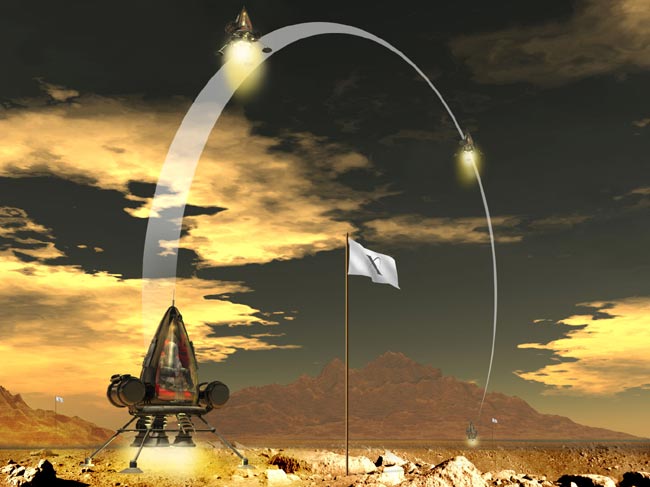X Prize Foundation Sets Draft Rules for Lunar Lander Challenge

The X PrizeFoundation is seeking public comment on draft rules for a lunar lander contestset for later this year.
The $2million Lunar Lander Challenge, part of NASA’s Centennial Challengesprogram to encourage development of low-cost space technologies, offers cashprizes for the successful flight of a vertical launch and landing vehicle.
Foundationofficials plan to award up to five prizes of different denominations under twocategories – the toughest challenge, a successful roundtrip on a mocklunar landscape, nets $1 million – during its 2006 XPrize Cup event this October. [A complete set of draft rules is available here.]
“Thepurpose of public comment is strictly for support,” X Prize Foundation spokespersonIan Murphy told SPACE.com, adding that final rules will be releasedbased on feedback on the draft set.
The X PrizeFoundation has a successful track record when it comes to space-themedcompetitions. The group led the successful $10 million Ansari XPrize competition – which challenged teams to build and launch apiloted suborbital spacecraft twice in two weeks – then established plansfor the annual XPrize Cup. SpaceShipOne,a rocketship built by Mojave, California’s Scaled Composites andaerospace veteran Burt Rutan, wonthe X Prize purse.
“Ourgoals are completely parallel,” Murphy said of the foundation and NASA.“We want NASA to make things possible, and we, space industry, want tomake things profitable.”
Accordingto draft rules for the lunar lander contest, competitors will be challenged tobuild a vehicle capable of launching vertically, travel a distance of 328 to656 feet (100 to 200 meters) horizontally, and then land at a designated site.A return trip would then occur between 5 minutes and 30 minutes later.
Breaking space news, the latest updates on rocket launches, skywatching events and more!
The contestis expected to be divided into two levels, one for flat terrain, and the otherto resemble the lunar surface – with other cash prize amounts based onlevel difficulty and finish results.
For Level 1contests, vehicles must fly higher than 328 feet (100 meters) for about 90 seconds andland on flat terrain no more than 10 meters from a target. Level 2 competitionswill feature the mock lunar surface and a minimum flight time of 180 seconds,according to the draft rules.
Commentsare sought by March 1 with initial sign-ups slated for May 15, according todraft rules, though Murphy added that the comment period could be extended to30 days.
NASA worked withthe X Prize Foundation to develop its Centennial Challenges program,ultimately partneringin the Lunar Lander Challenge and the Suborbital Payload Challenge.
Thefoundation’s call for comments follows a similar action by the CentennialChallenges program earlier this month, when NASA announced preliminary rulesfor sixnew contests that ranged from power source demonstrations to space-basedfuel depot tests.
Comments onthe draft rules set for the Lunar Lander Challenge can be sent via e-mail tothe X Prize Foundation via e-mail at: LLComment@xprize.org.

Tariq is the award-winning Editor-in-Chief of Space.com and joined the team in 2001. He covers human spaceflight, as well as skywatching and entertainment. He became Space.com's Editor-in-Chief in 2019. Before joining Space.com, Tariq was a staff reporter for The Los Angeles Times covering education and city beats in La Habra, Fullerton and Huntington Beach. He's a recipient of the 2022 Harry Kolcum Award for excellence in space reporting and the 2025 Space Pioneer Award from the National Space Society. He is an Eagle Scout and Space Camp alum with journalism degrees from the USC and NYU. You can find Tariq at Space.com and as the co-host to the This Week In Space podcast on the TWiT network. To see his latest project, you can follow Tariq on Twitter @tariqjmalik.
